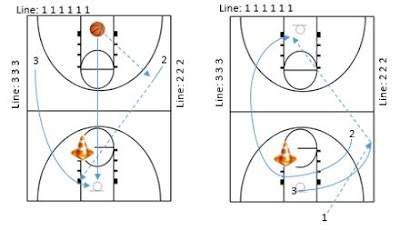Gary Colson Peer Pressure Drills
I first stumbled across peer pressure drills while searching
through the blog of coach legend Gary Colson at garycolson.wordpress.com.
Simply put, peer pressure drills are basic drills that you
probably use every day, but as a team, you won’t move on to another drill/skill
until you have completed a certain number of repetitions to perfection, either
in a row or in totality.
For example, every day, we start our practice with zig-zag
ball-handling. We set the cones up and complete
four different drills: (1) regular crossovers down and back, (2) between the
legs crossovers down and back, (3) behind the back down and back, (4) spin move
down and back. In order for us to move
on to the next drill, everybody has to do it correctly and make their lay-up
going down and coming back. One miss,
and we do that particular drill over again.
For every miss over one, we have a down and back. So, if we have 2 misses, we have 1 down and
back. If we have 3 misses, we have 2
down and backs. If we have 4 misses, we
have 3 down and backs, etc. We don’t
move on until it’s perfect. It can
sometimes take a while if our guys are being lazy or they aren’t engaged, but
after a few down and backs, I usually don’t have to worry about them regaining
their focus.
This is great skill work, gets our guys loose effectively,
and builds mental toughness.
Once we complete that, we do some kind of passing
drill. Sometimes, it’s the 3-man weave
where we have to complete a certain number of passes, no more or less without
allowing the ball to touch the ground, and finish with a made layup. Another passing drill that we use is what I
call ‘skips in transition.’ I have
diagrammed that drill below:
We have three lines. The line under the basket (1) gets the ball and makes an outlet pass to line 2. On the pass, line 3 sprints the floor on the opposite side. Line 2 then makes a skip pass to line 3. We emphasize 2 being able to make the pass to 3 and 3 catching it without the ball touching the ground. Our guys have a tendency to catch it off the bounce, but that slows you down.
The 3 lays it up, then sprints to the right wing the 1,
after making the outlet pass to 2, sprints the court and rebounds 3’s
layup. We preach getting the rebound before
it hits the ground. 1 then runs out of
bounds and makes an inbound outlet pass to 3.
2, after making the skip pass to 3, sprints around a cone that we put at
the elbow, and sprints the left side of the court. 3 makes the skip pass to 2 for the layup. A key part of the drill is making sure that 2
does not wait for the 1 and 3 to inbound the ball and sprints to the
block. If he gets to the block before
the pass is made, we have him spot up and wait for the pass their – we really
emphasize sprinting the court, looking for skips in transition, and being able
to make that pass.
With ‘skips in transition,’ I set a number of 10 perfect
drills in a row, down and back is 1. A
perfect drill is one where no passes touch the ground, clean catches, and made
layups. We can also set this drill to
time. If I were to do it by time, I
would do it in 3 minute intervals. In
college, we called this drill ’28 in 3’ because we had to have 28 perfect
layups in 3 minutes before we moved on.
Gary Colson has a really good passing drill that we have
used as well called ‘Prefect Lay-ups.’ I have that drill diagrammed below as
well, and it is something that we have used this spring to switch things up –
especially when we don’t have a lot of time because our ball-handling took too
long or we have other stuff we just need to get in.
The thing about ‘peer pressure’ drills is that the
philosophy behind it is solid in that it teaches fundamentals and ensures that
you do things efficiently and effectively with a built in checks and balance
system. You can also have the freedom to
implement whatever drills you want, just tie a ‘magic number’ to it and hold
the player accountable! Coach Colson
said that he has found that a lot of coaches who do not understand the
correlation between the drill and the magic number that you require, but he
says that the number is more important than the drill itself. Having to hit a certain number in a row keeps
players focused and engaged on the drill and helps ‘train the mind.’ Our players know that we will finish almost
every practice with some kind of ‘scrimmage’ play, but they also understand
that we have certain things to get through before we get there, and the better
we are at the other stuff, the more time they will have to play at the end. Putting this burden on them increases their
sense of urgency to get their work completed quickly.
I know that using these peer pressure drills has really
helped me find and efficient and productive way to work on the basic
fundamentals every day. I hope it helps
you.





Comments
Post a Comment